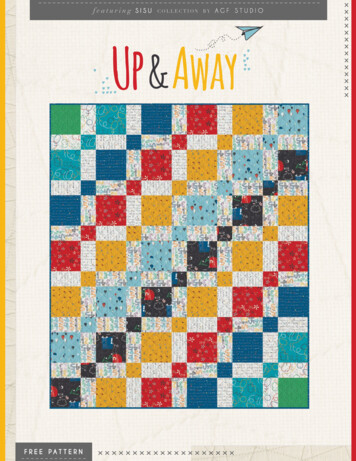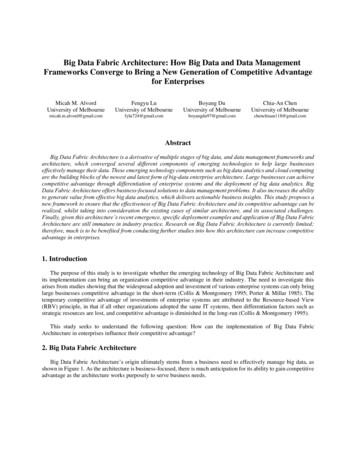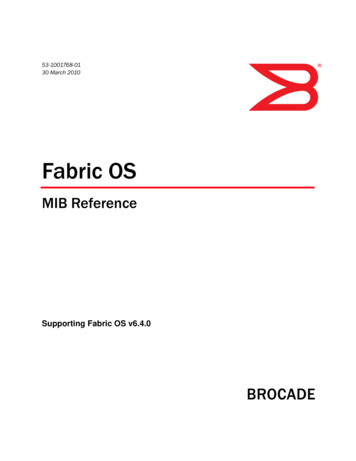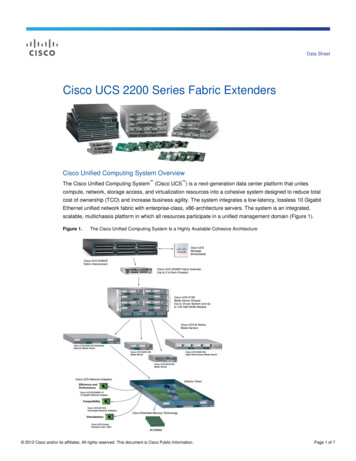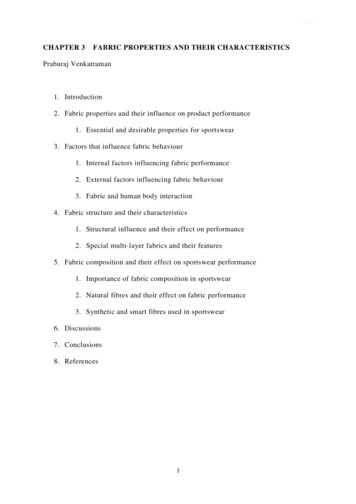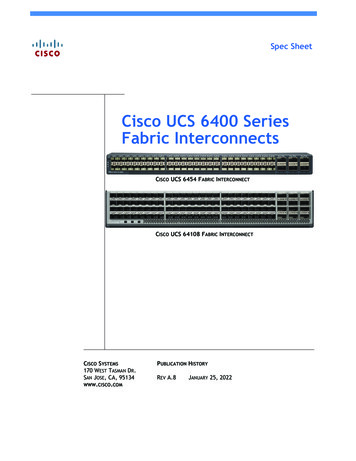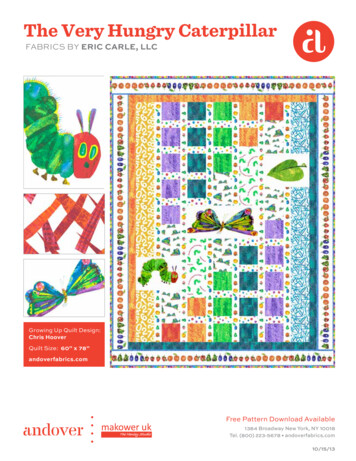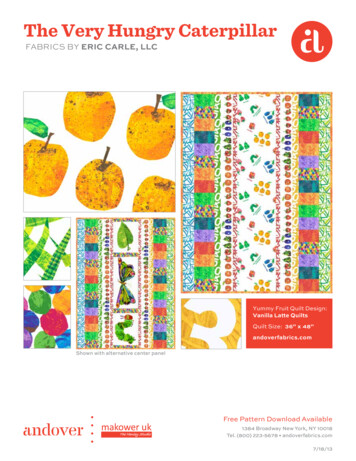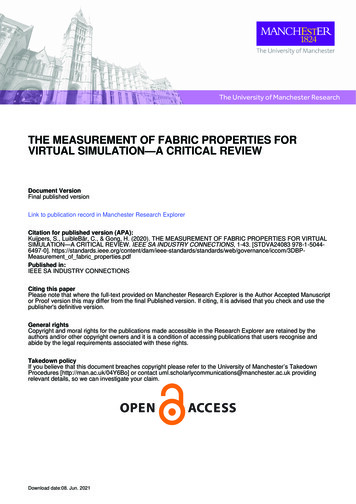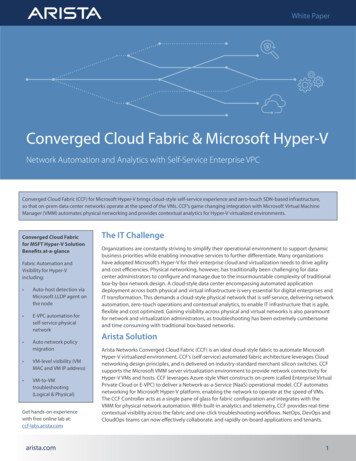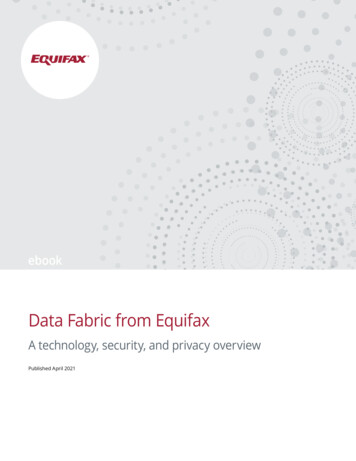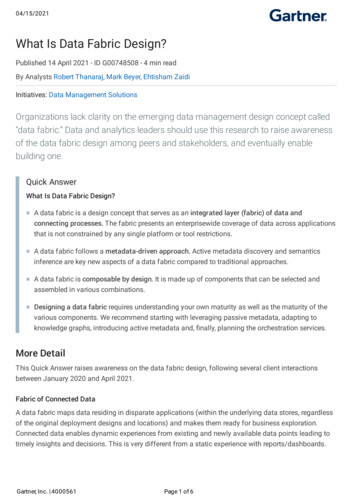
Transcription
04/15/2021What Is Data Fabric Design?Published 14 April 2021 - ID G00748508 - 4 min readBy Analysts Robert Thanaraj, Mark Beyer, Ehtisham ZaidiInitiatives: Data Management SolutionsOrganizations lack clarity on the emerging data management design concept called“data fabric.” Data and analytics leaders should use this research to raise awarenessof the data fabric design among peers and stakeholders, and eventually enablebuilding one.Quick AnswerWhat Is Data Fabric Design? A data fabric is a design concept that serves as an integrated layer (fabric) of data andconnecting processes. The fabric presents an enterprisewide coverage of data across applicationsthat is not constrained by any single platform or tool restrictions. A data fabric follows a metadata-driven approach. Active metadata discovery and semanticsinference are key new aspects of a data fabric compared to traditional approaches. A data fabric is composable by design. It is made up of components that can be selected andassembled in various combinations. Designing a data fabric requires understanding your own maturity as well as the maturity of thevarious components. We recommend starting with leveraging passive metadata, adapting toknowledge graphs, introducing active metadata and, finally, planning the orchestration services.More DetailThis Quick Answer raises awareness on the data fabric design, following several client interactionsbetween January 2020 and April 2021.Fabric of Connected DataA data fabric maps data residing in disparate applications (within the underlying data stores, regardlessof the original deployment designs and locations) and makes them ready for business exploration.Connected data enables dynamic experiences from existing and newly available data points leading totimely insights and decisions. This is very different from a static experience with reports/dashboards.Gartner, Inc. 4000561Page 1 of 6
04/15/2021Data fabric serves as a backbone for knowledge discovery, data analysis and augmented decisionmaking. For example, a supply chain leader using a data fabric can connect supplier delays withproduction delays (as and when these data points are available), identify developing risks and makeinformed decisions in real time, as shown in Figure 1.Figure 1: Data Fabric Serves an Integrated Layer of Connected DataMetadata-Driven ApproachThink of data fabric like a human brain — that can store information (data and metadata fromparticipating systems captured for graph analysis) and process information (the decision engines).A data fabric engages with two categories of metadata: Passive metadata: This includes traditional design-based metadata (such as data models, schemadefinitions, glossary) and runtime metadata (such as database query logs, integration job logs, dataquality audits).Gartner, Inc. 4000561Page 2 of 6
04/15/2021 Active metadata: It's the continuous analysis of data usage by systems and users to determinealignment and exception between “data as designed” versus “actual experiences”. It’s AI-driven,assisted by humans.The three-core metadata processing engines of a data fabric are: Usage and utilization engine: Processes the information captured about data subjects, systems, logsand users in the data fabric’s metadata repository Continuous inference engine: Infers the semantics of data by profiling the content and registering thefindings (such as the inferred data domain, data quality) in the fabric’s repository Alignment and exception engine: Compares designed metadata against inferred metadata and dealswith misalignmentsFigure 2 illustrates this metadata-driven approach to processing information.Gartner, Inc. 4000561Page 3 of 6
04/15/2021Figure 2: The AI Engines of a Data FabricComposable DesignA data fabric is made up of components that can be selected and assembled in various combinations(see Figure 3). The component maturity levels vary. As a result, data fabric implementations may varysignificantly.Using ontologies, the connected data is enriched with business semantics — modeling relationshipsacross heterogeneous applications. Compatible metadata and assured data quality are essential tojoining data across the enterprise into a common model.Using artificial intelligence (AI), the fabric recognizes similar data in previously unused or unknown (butnow available) data, and alerts users that “new data is available,” which might otherwise take weeks ormonths to discover. But when AI cannot infer the data, it can be set up to “scream for help” from humanallies who can explain the data, and then the fabric learns.Gartner, Inc. 4000561Page 4 of 6
04/15/2021Figure 3: Maturity of Data Fabric ComponentsDesigning a Data FabricIn our Hype Cycle for Data Management, 2020, we positioned the data fabric innovation profile atop thePeak of Inflated Expectations. During this stage, overenthusiasm and unrealistic projections prevail. Atthe moment, building a data fabric is not an easy task. However, organizations can and should invest inthe components of a data fabric now, and evolve the fabric design organically. Here is ourrecommendation: Start with your passive metadata by deploying an augmented data catalog. A catalog can help youcurate an inventory of information assets, communicate shared semantics, and collaborate foraccountability and governance. Progress your metadata discovery journey by adapting knowledge graphs. You build a fluid,connected data environment using uniform identifiers, flexible schemas and triples. As a startingpoint, choose a domain or subdomain that has a well-defined set of data and a use case that willdemonstrate impact. Introduce active metadata by enabling your data fabric to collect, share and analyze all forms ofmetadata. Feed the results to machine learning models that produce recommendations andautomation metrics as output.Gartner, Inc. 4000561Page 5 of 6
04/15/2021 Plan the integration and orchestration services for your data fabric — i.e., how and where will you runthe fabric. These services are best delivered by vendor products; otherwise, you need a high level ofskills.What’s Next?Take advantage of the recommended Gartner research on data fabric. Speak to our analysts — we canassist in shaping your data fabric business case and in selecting the right methodologies, architecturesand technology.Recommended by the AuthorsTop Trends in Data and Analytics for 2021: Data Fabric Is the FoundationData Fabrics Add Augmented Intelligence to Modernize Your Data IntegrationDemystifying the Data FabricInfographic: An Intelligent Composable Business Demands a Data FabricEmerging Technologies: Data Fabric Is the Future of Data ManagementHow to Build Knowledge Graphs That Enable AI-Driven Enterprise ApplicationsHow to Activate Metadata to Enable a Composable Data FabricCool Vendors in Data ManagementSolution Comparison of 7 Data Fabric Offerings 2021 Gartner, Inc. and/or its affiliates. All rights reserved. Gartner is a registered trademark of Gartner, Inc. and itsaffiliates. This publication may not be reproduced or distributed in any form without Gartner's prior written permission.It consists of the opinions of Gartner's research organization, which should not be construed as statements of fact.While the information contained in this publication has been obtained from sources believed to be reliable, Gartnerdisclaims all warranties as to the accuracy, completeness or adequacy of such information. Although Gartner researchmay address legal and financial issues, Gartner does not provide legal or investment advice and its research should notbe construed or used as such. Your access and use of this publication are governed by Gartner’s Usage Policy. Gartnerprides itself on its reputation for independence and objectivity. Its research is produced independently by its researchorganization without input or influence from any third party. For further information, see "Guiding Principles onIndependence and Objectivity."Gartner, Inc. 4000561Page 6 of 6
Take advantage of the recommended Gartner research on data fabric. Speak to our analysts — we can assist in shaping your data fabric business case and in selecting the right methodologies, architectures and technology. Recommended by the Authors Top Trends in Data and Analytics for 2021: Data Fabric Is the Foundation
